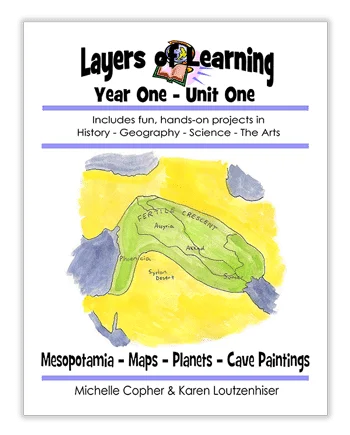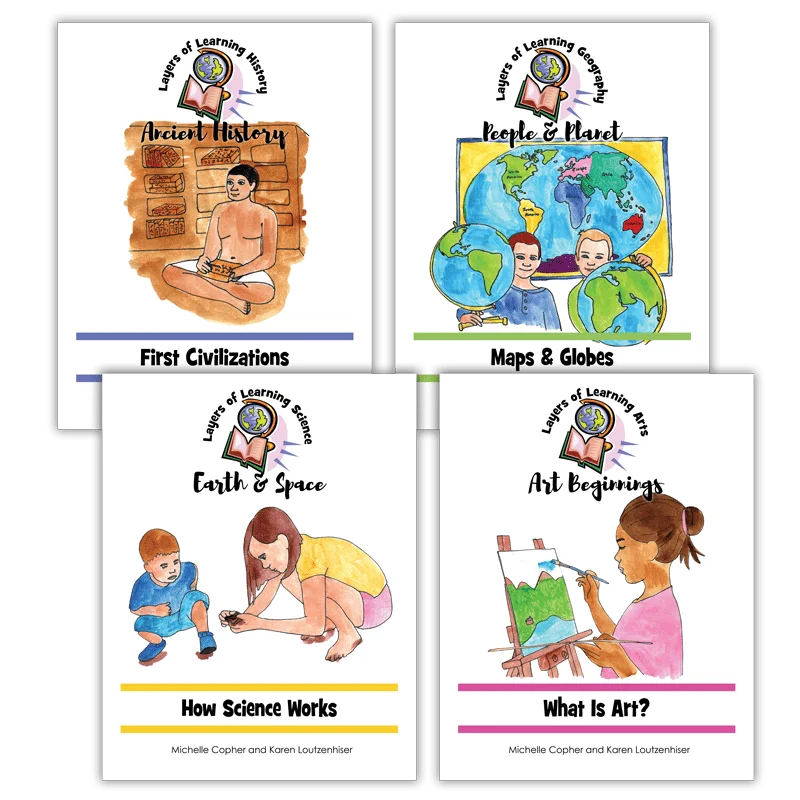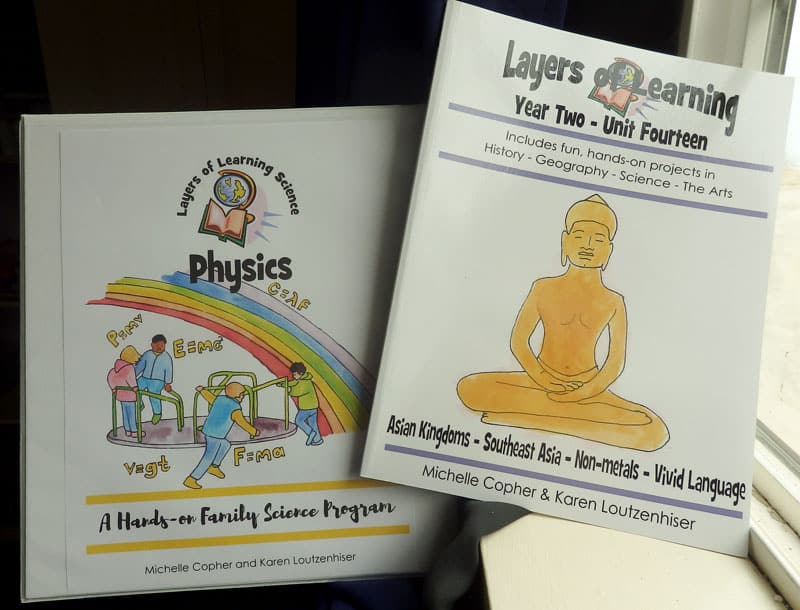Layers of Learning is homeschool curriculum that includes the subjects of history, geography, science, and arts. The first Layers of Learning units were released in 2010 and eventually included four “Years” of courses in these four subjects. Since then we, the authors, Michelle and Karen, have learned more about homeschooling through experience, the subjects we teach, and how other homeschoolers use a hands-on curriculum like this one. As a result we began writing a new, updated curriculum in 2019 and the first units of the new curriculum were released in spring of 2022.


We call the older curriculum “Classic Layers of Learning” and we call the updated version “NEW Layers of Learning” to help customers distinguish which curriculum they are buying. The Classic Layers of Learning is remaining available to purchase until the NEW Layers of Learning has been completely released, most likely sometime in 2025. So we want to make sure you know the difference and can make the best choice for your family.
Differences
Here is how the two versions are different from one another:
Classic Layers of Learning
- First released in 2010
- A scrapbook of our homeschooling as we went along teaching our kids
- All four subjects in one unit book
- Ideas of activities and experiments to do with kids sometimes accompanied by photos of the project or activity
- Approximately 10 activities per subject
- Twenty units per year
- All four branches of science (earth & space, biology, chemistry, and physics) are taught in each year.
NEW Layers of Learning
- First released in 2022
- A fleshed out sequential curriculum based on experience teaching kids with this method all the way through
- One subject per unit book
- Lesson plans with materials lists, photos, and step by step instructions
- Approximately 20 activities per subject
- Nine units per year
- Science is taught one branch per year (earth & space, biology, chemistry, then physics)
The NEW Layers of Learning improves on the Classic because of the experience we, Karen and Michelle, have gained in taking kids all the way through graduation with this method of learning, in the information we have learned about the subjects through further study, and based on feedback from customers whose awesome ideas have been incorporated. Things like bulleted lists of supplies, book colors that are coordinated to the subjects instead of random, step by step numbered instructions instead of just paragraphs, pictures for most of the explorations to show the completed project, and having just nine units per year (one for each month) to make planning easier.
We also have better tools now. Instead of writing the units on a word processing program we have professional software for book layouts, so the final product has better formatting and looks more polished.
Exploration Comparison
The lesson plans inside the books are called explorations in both the Classic and NEW curriculums. But the way they are written and laid out is different. Here is an example of the differences from two history units.
From Classic Layers of Learning, Unit 1-1

EXPLORATION: Mud Bricks
Many ancient homes were made of simple mud bricks. You can make your own. Just save the grass clippings the next time you mow your lawn. Get a bucket and mix grass clippings, dirt, and enough water to turn the dirt into mud. Mix them all together and form them into 2 inch rectangular blocks. Set them out to dry in the sun. They will harden into perfect building blocks for creating a miniature home.

From NEW Layers of Learning, First Civilizations

EXPLORATION: City Walls
For this activity you will need:
• Internet
• Clay (air dry or bake dry).Or use local clay if you have it.
• Chopped straw or dried grass
• Water
Humans are naturally competitive. We are war-like and
territorial, as a species. One of the advantages of building
cities was that they allowed larger numbers of people to
join together to defend against attacks from hostile groups. Ancient cities had walls and soldiers to defend them. The walls could be made of earth topped with wooden spikes, large stone blocks, wooden palisades, or most often, clay bricks baked and stacked.
- Look up some images online of ancient city ruins or
reconstructions of Uruk, Sumer, Thebes, or Harrapa.
Notice the city walls and the city gates. How big were
they? What were they protecting? What were they
made of? - Build your own bricks from clay. You will need to put your clay into a bowl, add a little water to soften it until it is a thick malleable paste. Add some chopped up straw to the clay and knead it in completely.
- Shape your clay into small bricks, then leave them out
in the sun to dry and harden. If you don’t have warm,
sunny days, you can dry them in the oven on low heat. - Stack your bricks into a wall.
- Write a mighty description of your city walls as though
you are the epic ruler who built them and you want
your great act to be remembered for all time. You
can mention all of the enemies they keep out and all
the people they protect, as well as their size and the
number of people it took to construct them.

You should notice that the NEW Layers of Learning has completely fleshed out explorations that translate into lesson plans, one for each day you are studying the subject. We took the old explorations and improved on them so they are easier for you to use.
Similarities
The learning method and philosophy of Layers of Learning remain unchanged as well as the basic format of the units. Here are ways the Classic and NEW are the same:
- Hands-on project based learning style
- Family-style, where all ages learn together
- Curriculum books are for the mentor. There are no text books for the student. Instead students learn by reading books and watching videos that you select from your library or online.
- Includes Library Lists of book recommendations
- Includes a Printable Pack of student worksheets
- Sidebars direct you to extra tidbits of information, famous people, extra books that are just off topic, rabbit trails of additional lesson directions, deep discussions to have with your kids, and writing ideas.
- Pick-and-choose method where the mentor has control over the information students receive and the emphasis that is put on topics. You choose which books, which activities, and which information.
- History is taught chronologically.
- The four subjects (history, geography, science, and art) overlap and are intertwined when possible to make more cohesive learning.
Additions to the NEW Layers of Learning
One big addition that we made to the NEW Layers of Learning is the final section “Show What You Know”. This section is not in the Classic Layers of Learning at all. It was added in response to parents who asked for more help in testing or assessing their students learning.
Since Layers of Learning is a pick-and-choose curriculum traditional pre-written tests do not work well. This section allows the mentor to quickly and easily create oral or written assessments in the form of tests, quizzes, games, writing assignments, or projects.
Here is the Show What You Know section from First Civilizations.


Notice that it starts with a coloring page or narration page. Then there is a quiz game. Next are ideas for writing assignments that coordinate with the Writer’s Workshop units. Finally is the Big Book of Knowledge where mentors gather all the facts you learned about during the unit to use as a quiz bank. Also along the left sidebar on the last page are some quiz questions from the unit. You can use these to quiz your kids if you covered the information and also use these as inspiration for writing your own questions.
Who Should Stick With Classic and Who Should Go For NEW?
For most people the NEW Layers of Learning is the way to go. It is the same program, but all grown up and polished. It has built-in helps for directing assessments and fleshed out lesson plans. It also has a more cohesive organization and structure. Plus with nine units per year it is much easier to schedule and plan.
If you have already been using Classic Layers of Learning, then you may want to keep using the Classic until you finish with Year Four. This is especially true if you are already used to the way Layers of Learning works and you don’t need the extra lesson plan structure and the assessment helps.
Until the entire NEW Layers of Learning is available, you may need to use the Classic Layers of Learning to teach topics that haven’t been released yet.
But if you are brand new to Layers of Learning definitely begin with the NEW version.
We’re so excited about all the changes and how much better the new program is. We never could have done it without you!
Get a Free Unit
Choose between the first unit in each Layers of Learning subject to try for free when you sign up for the newsletter.
We never spam and you can cancel your subscription at any time.


